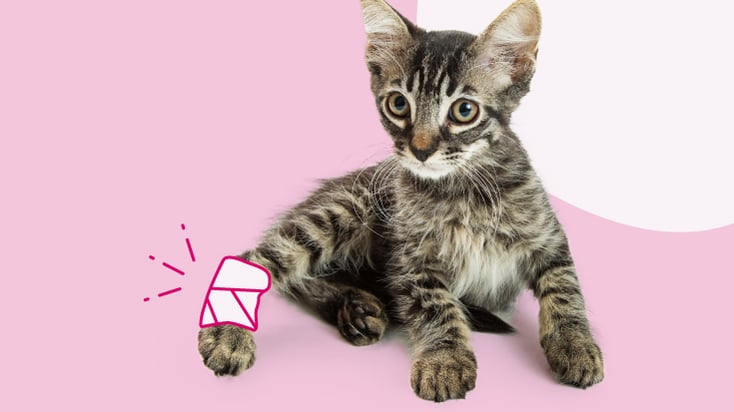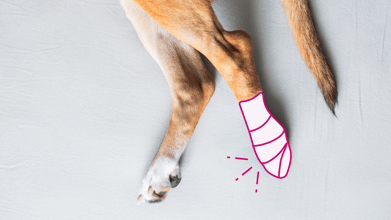Cat Wound Care: Types and Treatments

Table of Contents
Cats are naturally curious and adventurous, exploring their surroundings no matter where they are. However, this makes them prone to accidents and altercations with other animals, resulting in wounds.
While some minor injuries don't need treatment, others will require intensive treatment and attention. If left untreated, severe wounds may become infected and pose a threat to your cat's health.
Continue reading to learn more about cat wound treatment.
Types of Cat Wounds
A cat wound is an injury causing damage to your cat's skin or tissues. Wounds can be either open or closed.
- An open wound is when the skin gets torn, cut, or punctured. It is typically caused by falls, bites, or burns.
- Closed wounds are located under the skin and not exposed to air (for example, a bruise).
Here are some of the common wounds seen in cats.
Puncture wounds
A puncture wound is a small but often deep wound caused by bites or scratches and foreign material such as glass awns and thorns penetrating the skin.
Bite wounds
Bite injuries occur because of altercations with other animals, especially other cats. The skin and underlying tissues get punctures or abrasions. Insects can also cause bite wounds in cats.
In rare cases, bite wounds from an infected animal can cause rabies in cats.
Abrasions
Abrasions typically heal on their own, especially minor ones. If there's swelling, bleeding, pus, or odor on the wound, it has become infected. For this or if your cat is experiencing noticeable discomfort, seek veterinary care immediately.
Abscesses
Abscesses are walled infections found under the skin. They are usually bacterial. A feline abscess can cause cellulitis, fever, and pain to your furry friend, therefore needing thorough draining and cleaning by a veterinarian.
Sores
Sores affect different layers of your cat's skin. If untreated, these cat wounds can lead to tissue death. Sores are often slow to heal and must be treated properly to prevent infection.
Blisters
Blisters are small, defined elevations of the outer layer of the skin that are filled with a clear, watery fluid that separates out from the blood.
They are typically caused by burns or microbial infections, but may also be a sign of a more serious condition such as an autoimmune disease or skin cancer.
Immediate Response to Cat Injury
Here are some ways to immediately address your cat's bleeding wound.
- Apply pressure to stop the bleeding using a piece of gauze or a clean towel.
- Clean the wound with warm water and iodine or saline solution.
- Apply an antiseptic cream and non adherent gauze dressing, and gently wrap it in a clean bandage.
- Monitor the injury to make sure the bleeding has stopped.
- Consult your veterinarian to determine if further treatment is necessary.
If you are worried about your cat's injury, or if the cat's wound is not healing, consult a veterinarian immediately.
Immediate response to an open wound on a cat can help them heal quickly and prevent any further damage to your cat's health. After all, your cat doesn't want to exhaust one of its nine lives just because of a wound!
Should My Pet Be Seen by a Veterinarian?
1. Have you noticed changes in your pet’s appetite?
2. Does your pet have diarrhea or loose stools?
3. Have you noticed changes in your pet’s thirst/water consumption?
4. Is your pet having accidents in the house?
5. Is your pet pacing and unable to settle?
6. Is your pet panting more than usual?
7. Is your pet whining or vocalizing more than usual?
8. Is your pet shaking more than usual?
9. Is your pet hiding or avoiding physical contact more than usual?
10. Is your pet more lethargic and sleeping more than usual?
11. Are you concerned about changes in your pet’s behavior?
12. Is your pet scratching their ears?
13. Is your pet licking their paws more than usual?
14. Does your pet have a rash?
15. Is your pet moving more slowly than usual or having a harder time getting up or down?
View Results
Should My Pet Be Seen by a Veterinarian?
1. Have you noticed changes in your pet’s appetite?
2. Does your pet have diarrhea or loose stools?
3. Have you noticed changes in your pet’s thirst/water consumption?
4. Is your pet having accidents in the house?
5. Is your pet pacing and unable to settle?
6. Is your pet panting more than usual?
7. Is your pet whining or vocalizing more than usual?
8. Is your pet shaking more than usual?
9. Is your pet hiding or avoiding physical contact more than usual?
10. Is your pet more lethargic and sleeping more than usual?
11. Are you concerned about changes in your pet’s behavior?
12. Is your pet scratching their ears?
13. Is your pet licking their paws more than usual?
14. Does your pet have a rash?
15. Is your pet moving more slowly than usual or having a harder time getting up or down?
Share Quiz
Essential Supplies for Cat Wound Care
You will need a first aid kit for cat wound care. This will allow you to immediately address your cat's wounds.
- Tweezers
- Sterile, non-stick gauze
- Saline and antiseptic solutions for wound cleaning
- Bandage tape
- Bandages
- Alcohol wipes and cotton balls
How to Treat a Cat Wound at Home
If your cat has been wounded, here are some veterinarian approved steps to treat the wound at home:
1. Stop the blood flow
The first step in cat wound treatment is to stop any active bleeding. Apply direct pressure to the wound using a clean cloth or sterile gauze. This will cause a blood clot to form.
2. Clean the wound
Use a clean, wet cloth, antiseptic solution, and warm water to gently clean the cat's wound. Remove excess hair or debris from the wound area if necessary.
This also allows you to better assess the situation. If you feel the wound might be severe, or you are unsure, contact your veterinarian for advice.
3. Apply a dressing
Mild wounds should not need a dressing, but more severe injuries need to be covered to keep them clean while they heal. Unfortunately, many dressings designed for human skin don't stick to cats well.
When applying a dressing or bandage, it's important not to wrap anything around your cat's body or limb too tightly, as it can impede blood flow. If you have not been shown how to apply a bandage to your cat, you can apply a very loose bandage to keep the area clean until your veterinarian is able to examine your pet.
4. Monitor their progress
Once the healing process starts, you need to keep your cat from licking, scratching, or chewing their wound. Change the dressing daily and check for any wound infection signs, such as swelling, discharge, or an unpleasant smell. If you notice these signs, contact your veterinarian immediately.
Implementing proper wound care for cats prevents infections and any pain or discomfort. Plus, the cat wounds can heal faster, helping your pet return to their lively selves in no time!
When to Seek Professional Veterinary Care for Cats
Generally, minor wounds in cats can be treated at home and will heal by themselves. However, if your cat has severe wounds, you need to get them seen by a veterinarian as an emergency.
Some of these injuries include:
- Deep wounds
- Bites
- Wounds with foreign objects
- Long or deep lacerations
- Blisters and sores
- Wounds resulting from trauma such as a road accident or falling from a height
It is important to get these wounds assessed and treated early, to prevent your cat's condition from deteriorating.
Medications and Topical Treatments for Cats Injuries
Common prescription medications for a cat's wound include the following:
- Non-steroidal anti-inflammatory drugs (NSAIDs): These are commonly given after surgery or trauma. Side effects could include vomiting, diarrhea, bloody or dark-colored feces, and lethargy.
- Antibiotics: Open wounds, especially bite wounds, are at risk of bacterial infection. Your cat will likely need to take oral antibiotics, or be given a long-acting injection. In mild cases, you may be given an antibiotic ointment to apply to the area. Antibiotics have side effects such as diarrhea, but are usually well tolerated.
For better pain management, it's best that you give your cat veterinarian-prescribed medication. Cats and humans have different physiology, and giving cats human-specific medication may be toxic and worsen their condition.
Veterinary Procedures for Cat Wound Treatment
Veterinarians start by diagnosing your cat's wound. This will be the basis of their treatment. The veterinarian may need to sedate or anesthetize your cat to make wound cleaning and sanitizing more comfortable for them.
Wounds require different treatment approaches, with some requiring stitches or sutures, or surgical closure in worst cases. After cleaning the wound or after operating your cat, the veterinarian may bandage the wound.
Wound aftercare is important to prevent infection and further damage to the tissues. Proper aftercare will also help the wound heal quicker. This may include cleaning the wound once or twice a day and changing the dressing. You must also prevent your cat from licking the wound, as they can cause further damage and introduce bacteria from their tongue.
Cat Wound Preventative Measures
Since cats are more likely to be injured outdoors, the best preventive measure for wounds is to keep your cat indoors as much as possible. It is also essential to know the common hazards for cats so you can help keep your cat safe.
However, this doesn't eliminate the risk of cat wounds. Cats should be checked regularly for any health issues.
Conclusion
Cat wound care is essential to help your cat heal faster, but wounds have varying degrees of severity, requiring different approaches. Treating cat wounds properly will prevent infections and other health-damaging problems.
Is your feline friend struggling with a wound? Contact us today for a checkup to assess your cat's health condition!






